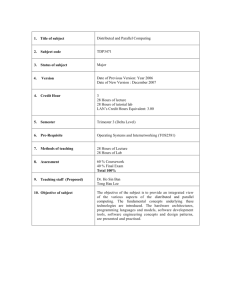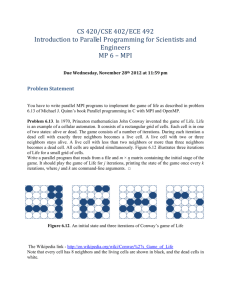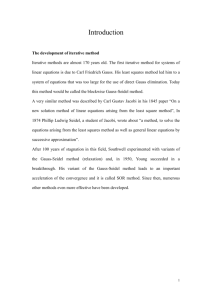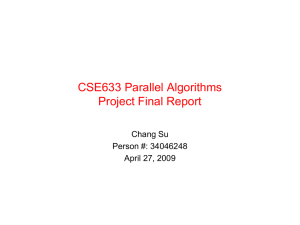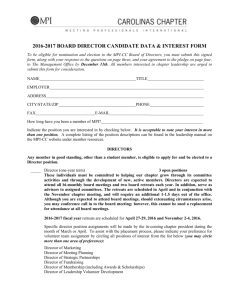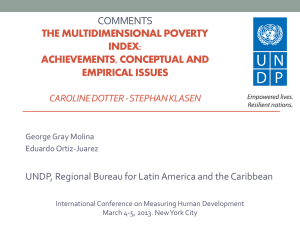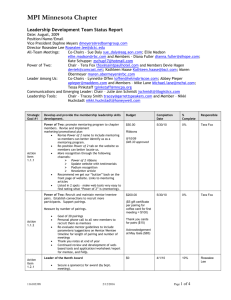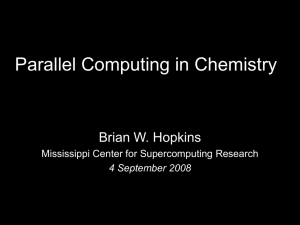here
advertisement
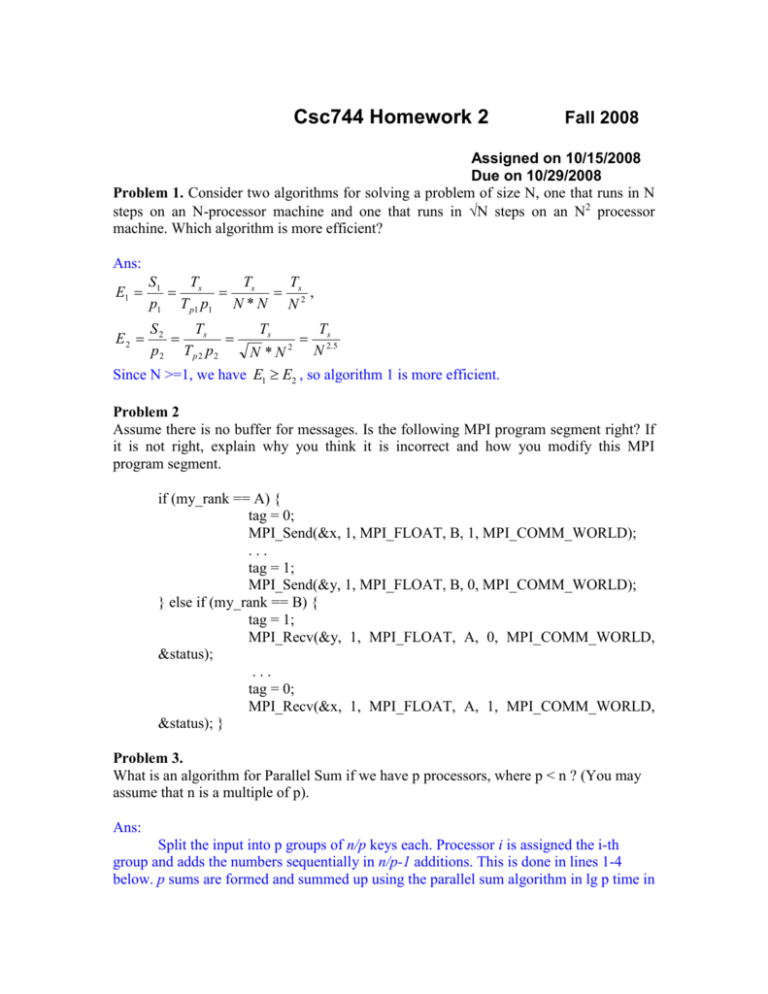
Csc744 Homework 2
Fall 2008
Assigned on 10/15/2008
Due on 10/29/2008
Problem 1. Consider two algorithms for solving a problem of size N, one that runs in N
steps on an N-processor machine and one that runs in N steps on an N2 processor
machine. Which algorithm is more efficient?
Ans:
E1
T
Ts
T
S1
s
s2 ,
p1 T p1 p1 N * N N
E2
Ts
S2
p2 T p 2 p2
Ts
N *N
2
Ts
N 2.5
Since N >=1, we have E1 E2 , so algorithm 1 is more efficient.
Problem 2
Assume there is no buffer for messages. Is the following MPI program segment right? If
it is not right, explain why you think it is incorrect and how you modify this MPI
program segment.
if (my_rank == A) {
tag = 0;
MPI_Send(&x, 1, MPI_FLOAT, B, 1, MPI_COMM_WORLD);
...
tag = 1;
MPI_Send(&y, 1, MPI_FLOAT, B, 0, MPI_COMM_WORLD);
} else if (my_rank == B) {
tag = 1;
MPI_Recv(&y, 1, MPI_FLOAT, A, 0, MPI_COMM_WORLD,
&status);
...
tag = 0;
MPI_Recv(&x, 1, MPI_FLOAT, A, 1, MPI_COMM_WORLD,
&status); }
Problem 3.
What is an algorithm for Parallel Sum if we have p processors, where p < n ? (You may
assume that n is a multiple of p).
Ans:
Split the input into p groups of n/p keys each. Processor i is assigned the i-th
group and adds the numbers sequentially in n/p-1 additions. This is done in lines 1-4
below. p sums are formed and summed up using the parallel sum algorithm in lg p time in
step 5. Total is n/p + lg p - 1. If n is not a multiple of p and lg p is not an integer, two
more steps are required.
Sum(n,p,A[0..n-1])
1 mypid = pid(); //pid = 0...p-1
2 sum[pid]=0;
3 for(i=0;i<n/p-1;i++)
4
sum[pid] = sum[pid] + A[pid*n/p+i];
5 ParallelSum(+,sum,Sum); //Parallel sum on p inputs
6 Return(Sum)
Problem 4. You are given n binary values X1,…, Xn. Find the logical OR of these n
values in constant time on a CRCW PRAM with n processors.
Ans:
The result stored in cell 0 is 0 (TRUE) unless a processor writes a 1 in cell 0; then
one of the Xi is 1 (TRUE) and the result X should be TRUE, as it is.
The algorithm is the following:
begin Logical OR (X1 . . .Xn)
1. Proc 1 writes 0 in cell 0.
2. if Xi = 1 processor i writes 1 into cell 0.
end Logical OR
Problem 5.
How fast can you evaluate in parallel xn for some input x and integer n? Express running
time, number of processors used and parallel work in terms of n. Your algorithm must
minimize all three parameters (for you to receive full credit).
Ans:
The sequential O(lg n) algorithm is hard to beat asymptotically.
A. Uniprocessor case. The algorithm works as follows. First compute all powers
2i
x , for all 2 i n , and if xn is none of them, find the binary representation of n. Then
j
form a product of all x 2 's for which the j-th bit in the binary representation of n is an 1.
This will get you xn. For example, x 31 x16 x 8 x 4 x 2 x1 .
Power( x, n)
1. k = floor(lgn); X[0]=x;
2. for (i=1;i<=k;i++)
3.
X[i] = X[i-1]*X[i-1] // Form all powers X[i]=x**(2^i)
4. n= B[k]B[k-1]...B[0] //binary representation of n
5. if (B[0] == 1) P=X;
6.
else P=1;
7. for(i=1;i<=k;i++);
8.
if (B[i]==1) P= P* X[i]; //multiply all power X[i] for which B[i] is an one
9. return(P); //Done
If you analyze carefully the algorithm above running-time is 2lg n . P = 1, W = W2 =
θ(lg n), T = 2lg n .
B. Two-processor case.
What if we have two processors? One can (almost) halve the time as follows: One
i
of the two processors computes the x 2 (or the X[i] terms in our pseudocode), one per
step, and a second processor decides, based on bit manipulations of n, whether to include
i
x 2 in the product that will compute xn. So one processor does lines 2-3 and the other
lines 7-8 of the sequential Power; everything works fine because the computation of the
two processors is interlaced (i.e. one step of one, is followed by one step of the
other). We show this program Power_2 in the following pseudocode.
Running time of Power_2 is T = lg n + 1. But we use two processors. P = 2, W = W2 =
θ (lg n), T = lg n + 1.
Power_2 (x,n)
Step
Proc 0
0:
X[0]=x
1:
X[1] = x**(2**1)
2:
| Proc 1
| P ; n;
| x=X[0];
| if (LSB(n)==1) P=x //Determine B[0]
| else P=1
| n=SHR(n);
| if (n==0) return(P);
| if (LSB(n)==1) P= P*X[1];//Determine B[1]
| n=SHR(n);
| if (n==0) return(P);
|
X[2]=X[1]*X[1]
// X[2]= x**(2**2)
.....
i:
X[i]=X[i-1]*X[i-1]
// X[i]= x**(2**i)
k=lgn :
X[k]=X[k-1]*X[k-1]
// X[k]= x**(2**k)
k+1 :
No-operation
|
| if (LSB(n)==1) P= P*X[i-1];//DetermineB[i-1]
| n=SHR(n);
| if (n==0) return(P);
|
|
| if (LSB(n)==1) P= P*X[k-1];//Det. B[k-1]
| n=SHR(n)
| if (n==0) return(P)
|
| if (LSB(n)==1) P= P*X[k]; //Det B[k]
return(P);
Can we do exponentiation faster or with less work?
Any other parallel algorithm will do more work, or spend more time.
(Not required, but) One can prove by a simple inductive argument, if only multiplications
i
are used in the computation of xn, that in the i-th step all powers up to x 2 can only be
computed. Thus xn requires at least lg n steps.


